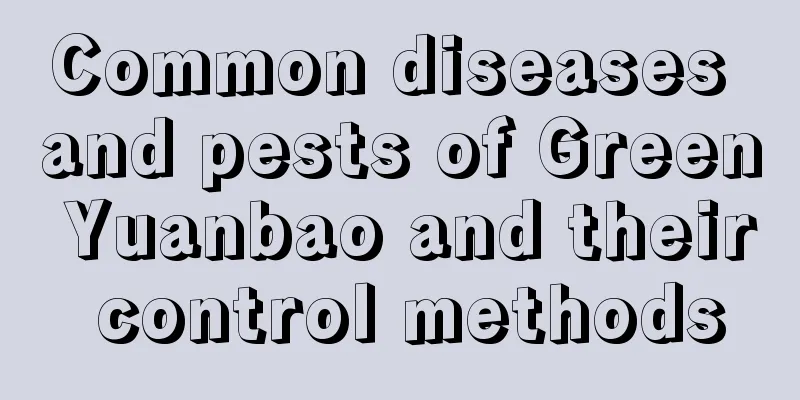Common diseases and pests of Green Yuanbao and their control methods

Common diseases of green yuanbao: powdery mildewSymptomsPowdery mildew of Green Yuanbao usually infects the leaves first. The symptoms of the disease mostly occur on the back of the leaves. In the early stage, there are chlorotic spots on the leaves. When the disease is serious, it is covered with powdery coal layers. In the later stage, the diseased leaves are covered with small black spots, which are the cleistothecia of the pathogen. The pathogen is phyllactinia corylea karst, which belongs to the genus Phyllactinia, family Erysiphelaceae, class Pyrocomycetes, subphylum Ascomycota. The hyphae grow on the surface and extend into the epidermal cells. The diameter of the closed theca is 70-119um, with 5-10 appendages, which are hyphae-like, brown, and have septa. Occurrence patternThe occurrence pattern of powdery mildew of Green Yuanbao: the pathogen overwinters on the diseased remains in the form of closed ascocysts. When the spring is warm the following year and conditions are suitable, ascospores are released for initial infection, and then conidia are produced for secondary infection, spreading through wind and rain. The disease has a long duration and can occur from May to September, but is more severe in August and September. Prevention and treatment methodsThe agent can be 1500-2000 times diluted 25% triadimefon wettable powder, or 1000 times diluted 70% thiophanate-methyl wettable powder. Spray once every 10 days, and the number of sprays depends on the progression of the disease. During the dormant period of plants in winter or early spring, 3-5 degrees Baume lime sulfur mixture can be used to spray the nursery ground. During the germination period in early spring, 0.3-0.5 degrees Baume solution can be used. When using eradicants, the effect will be better if combined with the removal of pathogens. Common pests of green yuanbao: spiny mothPest symptomsThe larvae feed on the leaves. Young ones eat the leaf flesh; older ones form notches and holes. In severe cases, the plant will be eaten down to the bare stalks. Occurrence patternThere is one generation per year in the north, two generations in the lower reaches of the Yangtze River, and three generations in a few areas. The mature larvae overwinter in the cocoons in the 3-6cm soil layer under the trees before pupating. In the first generation area, pupation begins in mid-May, and pupation and egg-laying begin in early June. The occurrence period is irregular, and newly hatched larvae can be seen from mid-June to early August. The damage is most serious in August. From late August, they begin to mature and bury themselves in the soil to form cocoons to overwinter. Prevention and treatment methodsDuring the peak period of larvae, spray 1200 times diluted 80% DDT EC, 1000 times diluted 50% phoxim EC, 1000 times diluted 50% malathion EC, 1000 times diluted 25% phosmet EC, 1500 times diluted 25% Acumin EC, 3000 times diluted 5% Levofloxacin EC. |
<<: Diseases and Pests of Nymphoides and Their Control Methods
>>: Common diseases of Cleome and their prevention and control methods
Recommend
Can red beans be planted in the soil?
Can red beans be planted in the soil? Red beans a...
How to grow citrus in pots
How to grow citrus in pots Temperature and light ...
Cultivation methods and precautions of clown firethorn
1. Maintenance methods 1. Soil: Choose soil that ...
What fertilizer to use for hydroponic white palm
1. What fertilizer to use Anthurium can be grown ...
When to sow lotus seeds
Lotus seed sowing time Lotus seeds are the seeds ...
How to grow the Maruleaf Dieffenbachia in full bloom?
How to grow the Maruleaf Dieffenbachia Sedum sphe...
How to fertilize Osmanthus fragrans
spring: Spring is the growing season for sweet ol...
Does Aspidistra like the sun?
Aspidistra sinomenina Aspidistra likes the sun. G...
How to care for the beautiful water tower flower with beautiful flowers and leaves
Pot soil When cultivating water tower flowers, in...
What to do if white spots appear on Christmas cactus leaves
1. Pests (1) There is a kind of insect called “sc...
How many pounds of windproof per mu
Yield per mu of windproof Under normal circumstan...
Cultivation methods and maintenance of old hackberry piles
Cultivation method of old hackberry stump 1. Temp...
How to use lucky bamboo for bonsai shaping
1. Jungle Bonsai The jungle-style bonsai has a si...
Why Amaryllis does not bloom?
1. Not yet in time It takes about 2-3 years for A...
How to propagate raspberries
Difficulty of propagating raspberries Raspberry, ...









